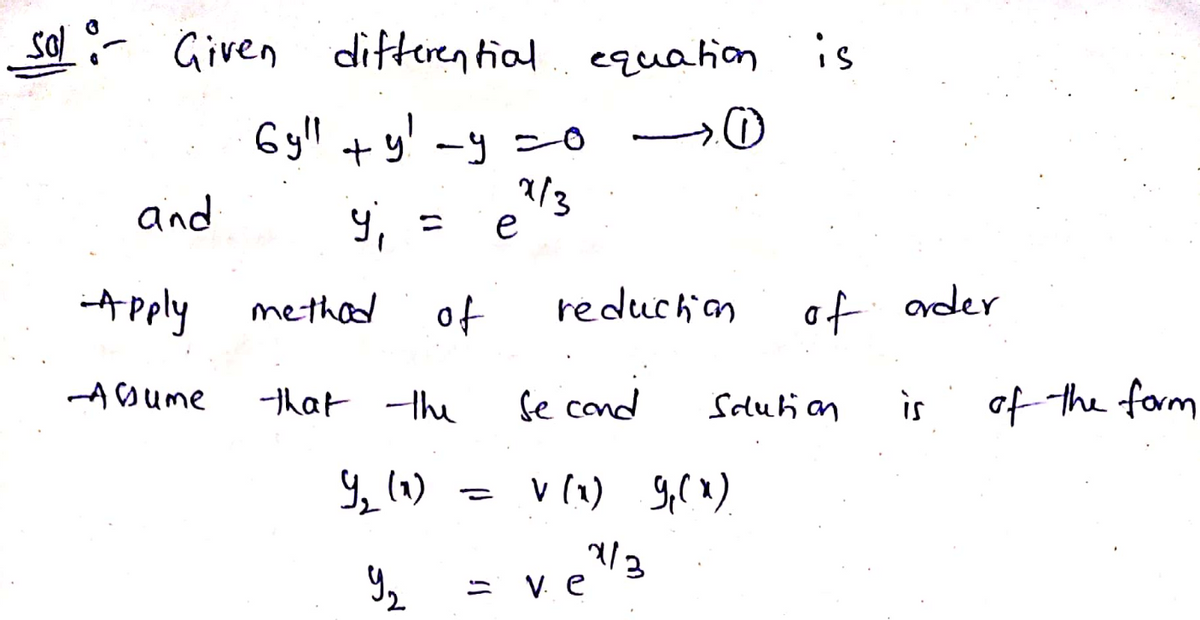
Advanced Engineering Mathematics
10th Edition
ISBN: 9780470458365
Author: Erwin Kreyszig
Publisher: Wiley, John & Sons, Incorporated
expand_more
expand_more
format_list_bulleted
Concept explainers
Question
Please show all work
![**Problem Statement:**
Apply the method of reduction of order (not its formula) to find the second solution of the differential equation given by:
\[ 6y'' + y' - y = 0 \]
where the first solution is:
\[ y_1 = e^{\frac{x}{3}} \]
**Explanation for Educational Website:**
In this problem, we are tasked with finding the second solution to a second-order linear homogeneous differential equation using the method of reduction of order. The differential equation provided is:
\[ 6y'' + y' - y = 0 \]
We are given that \( y_1 = e^{\frac{x}{3}} \) is one solution to the equation.
To apply the reduction of order method, one typically assumes the second solution \( y_2 \) takes the form:
\[ y_2 = v(x) y_1 \]
where \( v(x) \) is a function to be determined. By substituting \( y_2 \) and its derivatives into the original differential equation, and using the known solution \( y_1 \), you can solve for \( v(x) \).
This method eliminates certain terms, simplifying the problem and allowing you to find a particular expression or differential equation for \( v(x) \). Solving this will yield the unknown second solution \( y_2 \).](https://content.bartleby.com/qna-images/question/4c1e8b90-227b-4a9c-b073-26e8337ecb0b/94dfb72a-b5a5-4b93-8d43-d029f3d3dfa8/jv4rkxd_thumbnail.jpeg)
Transcribed Image Text:**Problem Statement:**
Apply the method of reduction of order (not its formula) to find the second solution of the differential equation given by:
\[ 6y'' + y' - y = 0 \]
where the first solution is:
\[ y_1 = e^{\frac{x}{3}} \]
**Explanation for Educational Website:**
In this problem, we are tasked with finding the second solution to a second-order linear homogeneous differential equation using the method of reduction of order. The differential equation provided is:
\[ 6y'' + y' - y = 0 \]
We are given that \( y_1 = e^{\frac{x}{3}} \) is one solution to the equation.
To apply the reduction of order method, one typically assumes the second solution \( y_2 \) takes the form:
\[ y_2 = v(x) y_1 \]
where \( v(x) \) is a function to be determined. By substituting \( y_2 \) and its derivatives into the original differential equation, and using the known solution \( y_1 \), you can solve for \( v(x) \).
This method eliminates certain terms, simplifying the problem and allowing you to find a particular expression or differential equation for \( v(x) \). Solving this will yield the unknown second solution \( y_2 \).
Expert Solution
arrow_forward
Step 1

Step by stepSolved in 3 steps with 3 images

Knowledge Booster
Learn more about
Need a deep-dive on the concept behind this application? Look no further. Learn more about this topic, advanced-math and related others by exploring similar questions and additional content below.Similar questions
arrow_back_ios
arrow_forward_ios
Recommended textbooks for you
 Advanced Engineering MathematicsAdvanced MathISBN:9780470458365Author:Erwin KreyszigPublisher:Wiley, John & Sons, Incorporated
Advanced Engineering MathematicsAdvanced MathISBN:9780470458365Author:Erwin KreyszigPublisher:Wiley, John & Sons, Incorporated Numerical Methods for EngineersAdvanced MathISBN:9780073397924Author:Steven C. Chapra Dr., Raymond P. CanalePublisher:McGraw-Hill Education
Numerical Methods for EngineersAdvanced MathISBN:9780073397924Author:Steven C. Chapra Dr., Raymond P. CanalePublisher:McGraw-Hill Education Introductory Mathematics for Engineering Applicat...Advanced MathISBN:9781118141809Author:Nathan KlingbeilPublisher:WILEY
Introductory Mathematics for Engineering Applicat...Advanced MathISBN:9781118141809Author:Nathan KlingbeilPublisher:WILEY Mathematics For Machine TechnologyAdvanced MathISBN:9781337798310Author:Peterson, John.Publisher:Cengage Learning,
Mathematics For Machine TechnologyAdvanced MathISBN:9781337798310Author:Peterson, John.Publisher:Cengage Learning,


Advanced Engineering Mathematics
Advanced Math
ISBN:9780470458365
Author:Erwin Kreyszig
Publisher:Wiley, John & Sons, Incorporated

Numerical Methods for Engineers
Advanced Math
ISBN:9780073397924
Author:Steven C. Chapra Dr., Raymond P. Canale
Publisher:McGraw-Hill Education

Introductory Mathematics for Engineering Applicat...
Advanced Math
ISBN:9781118141809
Author:Nathan Klingbeil
Publisher:WILEY

Mathematics For Machine Technology
Advanced Math
ISBN:9781337798310
Author:Peterson, John.
Publisher:Cengage Learning,

